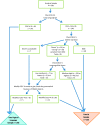Identifying Children at Risk for Language Impairment or Dyslexia With Group-Administered Measures
- PMID: 29222567
- PMCID: PMC5962925
- DOI: 10.1044/2017_JSLHR-L-16-0473
Identifying Children at Risk for Language Impairment or Dyslexia With Group-Administered Measures
Abstract
Purpose: The study aims to determine whether brief, group-administered screening measures can reliably identify second-grade children at risk for language impairment (LI) or dyslexia and to examine the degree to which parents of affected children were aware of their children's difficulties.
Method: Participants (N = 381) completed screening tasks and assessments of word reading, oral language, and nonverbal intelligence. Their parents completed questionnaires that inquired about reading and language development.
Results: Despite considerable overlap in the children meeting criteria for LI and dyslexia, many children exhibited problems in only one domain. The combined screening tasks reliably identified children at risk for either LI or dyslexia (area under the curve = 0.842), but they were more accurate at identifying risk for dyslexia than LI. Parents of children with LI and/or dyslexia were frequently unaware of their children's difficulties. Parents of children with LI but good word reading skills were the least likely of all impairment groups to report concerns or prior receipt of speech, language, or reading services.
Conclusions: Group-administered screens can identify children at risk of LI and/or dyslexia with good classification accuracy and in less time than individually administered measures. More research is needed to improve the identification of children with LI who display good word reading skills.
Figures




References
-
- Adlof S. M. (2016, July). Spoken word learning in children with SLI, dyslexia, and typical development. Paper presented at the meeting of the Society for the Scientific Study of Reading, Porto, Portugal.
-
- Archibald L. M., & Joanisse M. F. (2009). On the sensitivity and specificity of nonword repetition and sentence recall to language and memory impairments in children. Journal of Speech, Language, and Hearing Research, 52, 899–914. - PubMed
Publication types
MeSH terms
Grants and funding
LinkOut - more resources
Full Text Sources
Other Literature Sources

